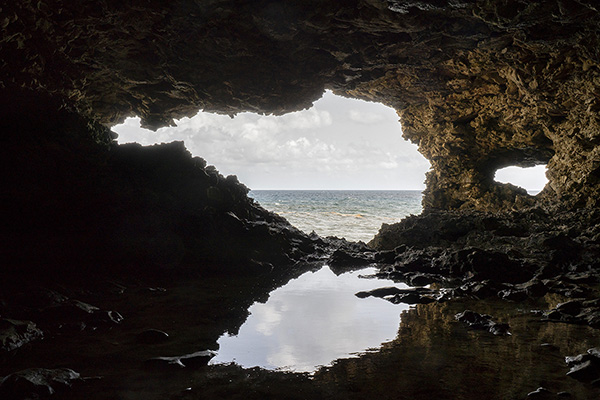By Ken Hubbard

Folkstone Marine Park: Tamron 10-24mm Di II – 1/160 sec, f/14, ISO 400 @19mm
A relatively small island that is only 21 miles long by 14 miles wide, Barbados is part of the lesser Antilles chain of islands of the Caribbean. The Islands first inhabitants go back centuries before the Spanish first visited the island and claimed it for the Spanish crown in the 15th century. By the early 17th century the English arrived in Barbados and took possession of it in the name of King James I in 1625. The island would remain a British colony for more than 300 years. In November of 1966 Barbados gained its independence from Britain and became a sovereign state of the commonwealth realm.

Bathsheba Beach: Tamron 28-75mm Di III – 1/800 sec, f/8, ISO 100 @ 75mm
Unlike most islands in the Caribbean that were formed by volcanoes, Barbados was created over hundreds of thousands of years by the natural impact of tectonic plates. For almost one million years under pressure of the Atlantic and Caribbean plates the oceanic sediment was pushed upward by tectonic uplift as the Atlantic plate slowly got pushed under the Caribbean plate. As the Caribbean plate rose the island slowly began to form and coral reefs began to be created in the shallow waters. As the island continued to rise, the once sea reef soon became inland reefs and are now the terraces and cliffs of the island.

Harrison Cave: Tamron 28-75mm Di III – 1/13 sec, f/5.6, ISO 2000 @ 28mm
An island that is best known for its beautiful beaches, colorful gardens and friendly locals also has much to offer below ground as well. The unique formation of the island has also created some truly fascinating geological features, one being its abundance of caves. A survey performed by professor Hans Machel of the University of Alberta revealed that the island has no less than 85 caves. One of the most popular caves for tourists to explore and see this underground world is Harrison Cave (http://www.harrisonscave.com). Located in the Parish of St Thomas, the cave is named for an early landowner in which the cave resides, Thomas Harrison. The earliest records of Harrison Cave go back to the late 1700’s, but do to its difficult entranceways it went mostly unexplored for centuries. Finally in 1974, Ole Sorrenson along with Tony Masson rediscovered the cave and mapped its dark passageways. Harrison Cave officially opened to the public in 1981.

Animal Flower Cave: Tamron 28-75mm Di III – 1/125 sec, f/14, ISO 400 @ 28mm
Another very popular cave for visitors to explore in Barbados is Animal Flower Cave (https://www.animalflowercave.com), which is located on the northern most point of the island in the parish of Saint Lucy. Originally discovered in 1780, this sea cave sits approximately 6 feet above sea level. You can make your way down into the cave via coral steps that were built in 1912 to view the cave and the sea anemones from which it derives its name.

Hunte’s Garden: Tamron 18-400mm Di II – 1/250 sec, f/16, ISO 640 @ 350mm
For those who love flora, Barbados is spotted with numerous gardens throughout the island to showcase all the different varieties that exist here. Located in a naturally formed gully in the parish of Saint Josephs is Hunte’s Gardens, created by horticulturist Anthony Hunte in the 1950’s. Hunte’s Gardens is a labyrinth of pathways that start at the upper edges of the gully and make their way down to the bottom where you walk through a series of mini gardens. Within these mini gardens are many areas to just sit back on the benches and chairs to relax or even have a picnic lunch. For even more garden experiences also check out Andromeda Botanical Gardens (http://www.andromedabarbados.com) and Flower forest (http://www.flowerforestbarbados.com).

St James Parish Church: Tamron 10-24mm Di II – 1/15 sec, f/6.3, ISO 400 @ 10mm
One of the greatest things about Barbados is the ability to easily and safely make your way around the island and immerse yourself into its culture and interact with locals. No matter where you are staying it is an easy cab or the local bus ride to just about anywhere you want to go. On Friday (and Saturday) nights one of the most popular things on the island to do by locals and tourists alike is to go to a fish-fry. There are numerous fish-fry’s throughout the island with one of the most popular being Oistin’s (https://barbados.org/oistins-fish-fry.htm#.W0N7ty-ZMcl). Located in the fishing town of Oistin, you can find multiple types of fish being cooked up, local arts and crafts and plenty of music. Rum has been a part of the Barbados culture for many years and the oldest rum distillery in existence today is still located on the island. Mount Gay Rum has been making rum since 1703. It is definitely worth the visit to see the distilling process and sample some rum, but make your way to some of the smaller distilleries on the island to get an even more intimate experience. One location, St. Nicholas Abbey (https://www.stnicholasabbey.com), does not only have great rum, but also has beautiful grounds you can walk through.

St Nicholas Abbey: Tamron 28-75mm Di III – 1/800 sec, f/11, ISO 200 @ 280mm
Lenses used in this article
Tamron 28-75mm Di III RXD
Tamron 10-24mm D II VC HLD
Tamron 18-400mm Di II VC PZD
